HR Development Report: Learning Styles and Training Initiatives
VerifiedAdded on 2020/06/03
|21
|6215
|482
Report
AI Summary
This report delves into the realm of Human Resource Development (HRD) with a specific focus on Tesco, a prominent retail firm. The report initiates with an introduction to HRD, emphasizing its significance in enhancing employee skills, knowledge, and overall performance. The first task involves a comparative analysis of various learning styles, including Kolb's learning style, cognitive learning, and behaviorist learning, followed by an exploration of the role and importance of the learning curve in the workplace, and the contribution of different learning styles and theories. Task 2 examines the training needs at different organizational levels, along with the advantages and disadvantages of on-the-job and off-the-job training methods. Task 3 focuses on developing and carrying out evaluations for training programs, reviewing the success of evaluation methods. The final task explores the government's role in training, development, and lifelong learning, the impact of competency development, and the contribution of contemporary training initiatives to HR development. The report concludes with a comprehensive overview of the key findings and recommendations for Tesco's HRD strategies.
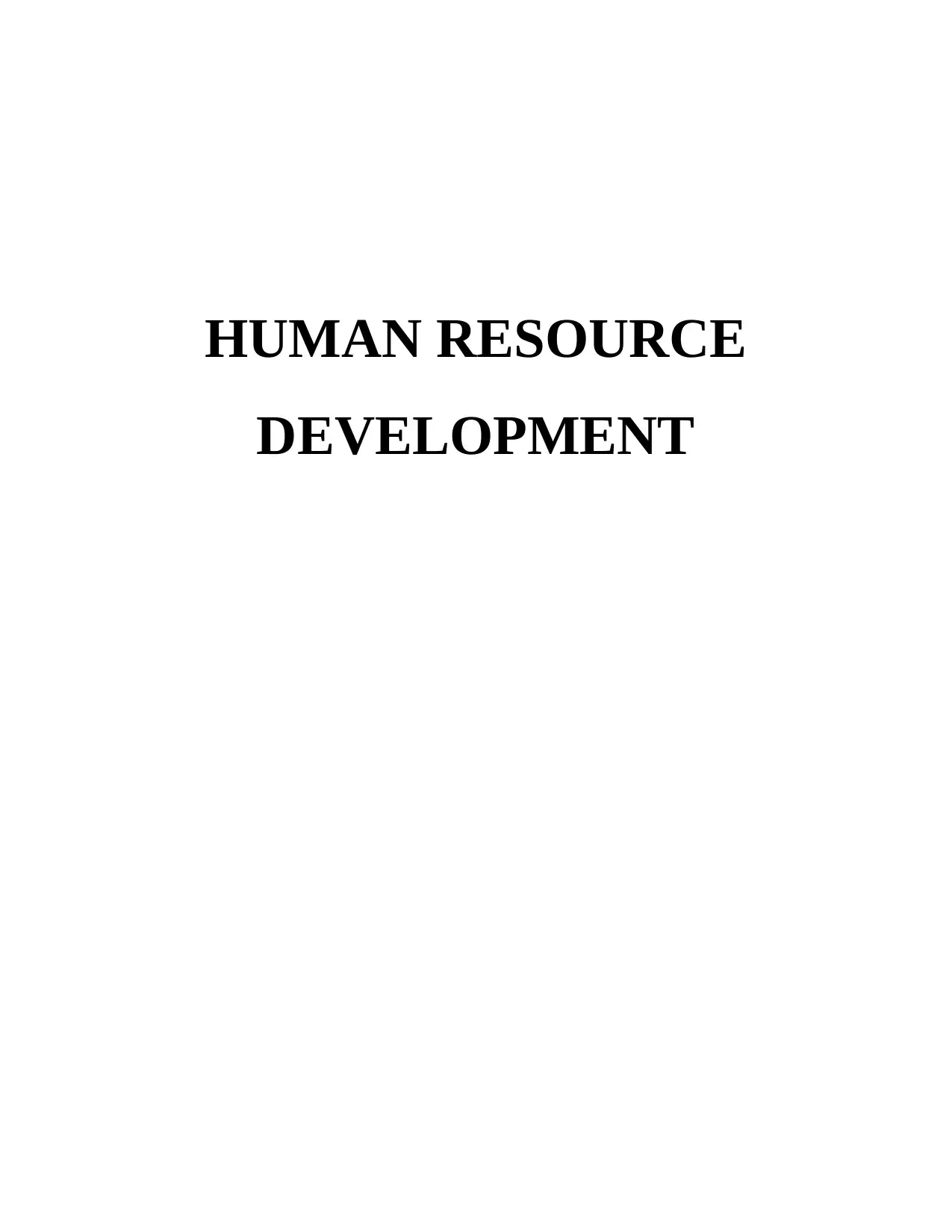
HUMAN RESOURCE
DEVELOPMENT
DEVELOPMENT
Paraphrase This Document
Need a fresh take? Get an instant paraphrase of this document with our AI Paraphraser
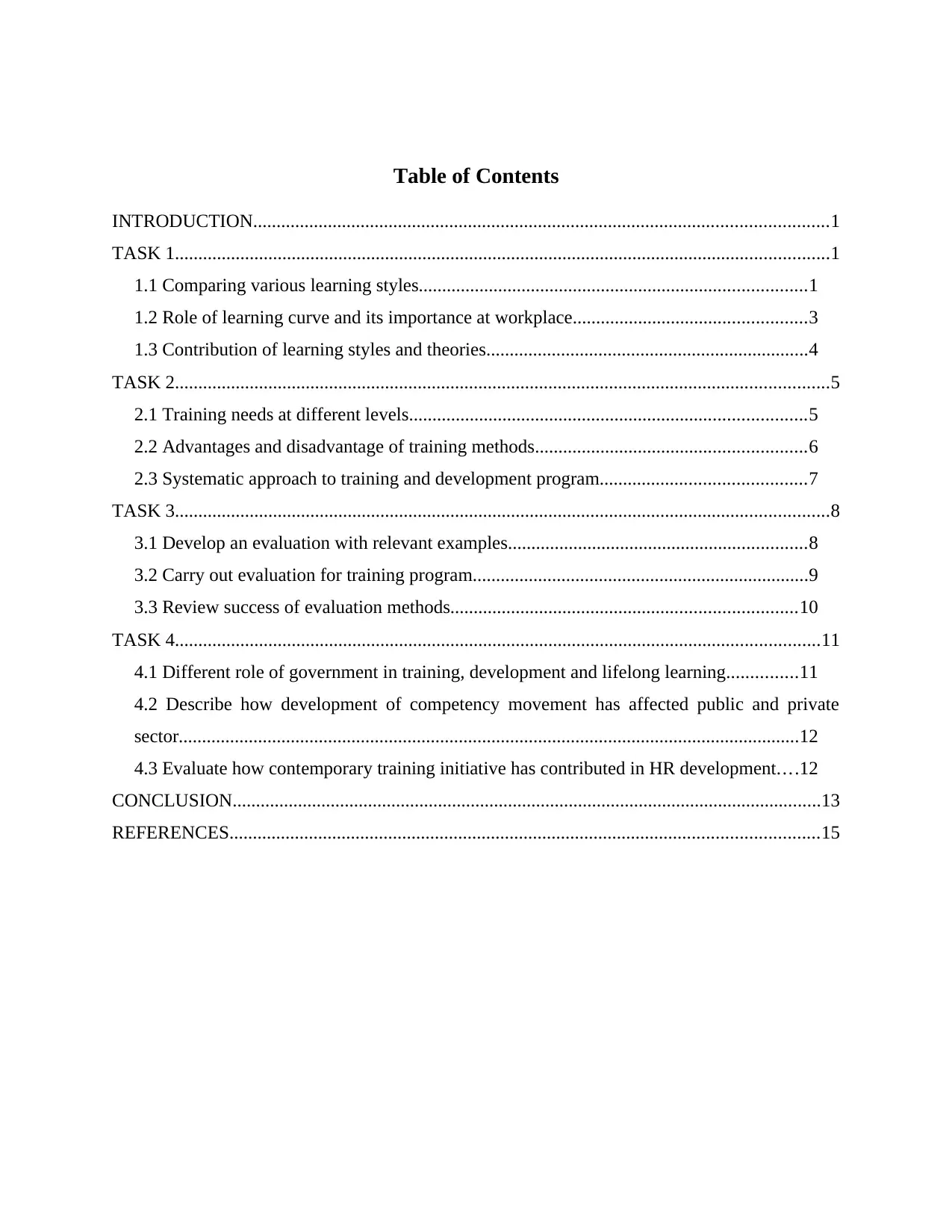
Table of Contents
INTRODUCTION...........................................................................................................................1
TASK 1............................................................................................................................................1
1.1 Comparing various learning styles...................................................................................1
1.2 Role of learning curve and its importance at workplace..................................................3
1.3 Contribution of learning styles and theories.....................................................................4
TASK 2............................................................................................................................................5
2.1 Training needs at different levels.....................................................................................5
2.2 Advantages and disadvantage of training methods..........................................................6
2.3 Systematic approach to training and development program............................................7
TASK 3............................................................................................................................................8
3.1 Develop an evaluation with relevant examples................................................................8
3.2 Carry out evaluation for training program........................................................................9
3.3 Review success of evaluation methods..........................................................................10
TASK 4..........................................................................................................................................11
4.1 Different role of government in training, development and lifelong learning...............11
4.2 Describe how development of competency movement has affected public and private
sector.....................................................................................................................................12
4.3 Evaluate how contemporary training initiative has contributed in HR development....12
CONCLUSION..............................................................................................................................13
REFERENCES..............................................................................................................................15
INTRODUCTION...........................................................................................................................1
TASK 1............................................................................................................................................1
1.1 Comparing various learning styles...................................................................................1
1.2 Role of learning curve and its importance at workplace..................................................3
1.3 Contribution of learning styles and theories.....................................................................4
TASK 2............................................................................................................................................5
2.1 Training needs at different levels.....................................................................................5
2.2 Advantages and disadvantage of training methods..........................................................6
2.3 Systematic approach to training and development program............................................7
TASK 3............................................................................................................................................8
3.1 Develop an evaluation with relevant examples................................................................8
3.2 Carry out evaluation for training program........................................................................9
3.3 Review success of evaluation methods..........................................................................10
TASK 4..........................................................................................................................................11
4.1 Different role of government in training, development and lifelong learning...............11
4.2 Describe how development of competency movement has affected public and private
sector.....................................................................................................................................12
4.3 Evaluate how contemporary training initiative has contributed in HR development....12
CONCLUSION..............................................................................................................................13
REFERENCES..............................................................................................................................15

⊘ This is a preview!⊘
Do you want full access?
Subscribe today to unlock all pages.

Trusted by 1+ million students worldwide
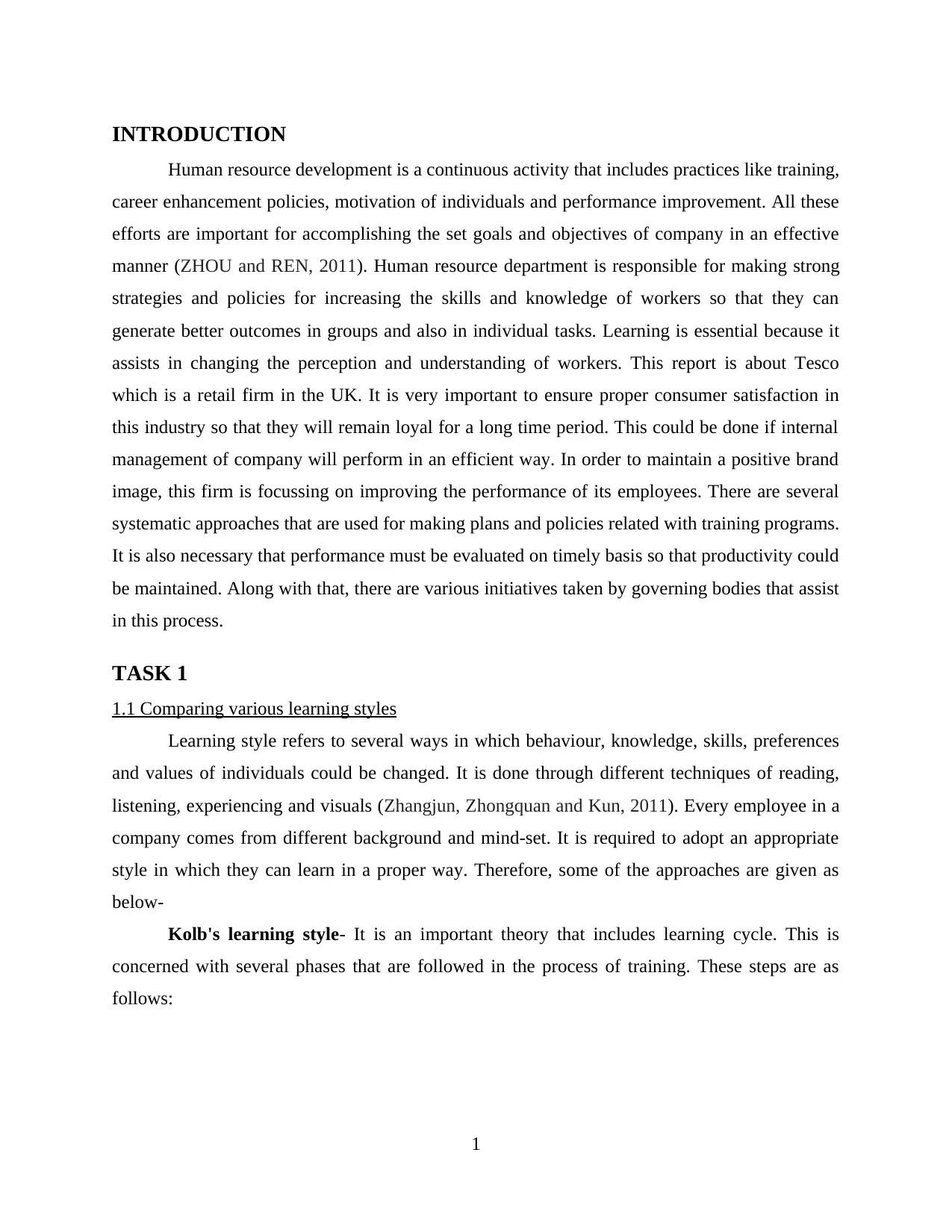
INTRODUCTION
Human resource development is a continuous activity that includes practices like training,
career enhancement policies, motivation of individuals and performance improvement. All these
efforts are important for accomplishing the set goals and objectives of company in an effective
manner (ZHOU and REN, 2011). Human resource department is responsible for making strong
strategies and policies for increasing the skills and knowledge of workers so that they can
generate better outcomes in groups and also in individual tasks. Learning is essential because it
assists in changing the perception and understanding of workers. This report is about Tesco
which is a retail firm in the UK. It is very important to ensure proper consumer satisfaction in
this industry so that they will remain loyal for a long time period. This could be done if internal
management of company will perform in an efficient way. In order to maintain a positive brand
image, this firm is focussing on improving the performance of its employees. There are several
systematic approaches that are used for making plans and policies related with training programs.
It is also necessary that performance must be evaluated on timely basis so that productivity could
be maintained. Along with that, there are various initiatives taken by governing bodies that assist
in this process.
TASK 1
1.1 Comparing various learning styles
Learning style refers to several ways in which behaviour, knowledge, skills, preferences
and values of individuals could be changed. It is done through different techniques of reading,
listening, experiencing and visuals (Zhangjun, Zhongquan and Kun, 2011). Every employee in a
company comes from different background and mind-set. It is required to adopt an appropriate
style in which they can learn in a proper way. Therefore, some of the approaches are given as
below-
Kolb's learning style- It is an important theory that includes learning cycle. This is
concerned with several phases that are followed in the process of training. These steps are as
follows:
1
Human resource development is a continuous activity that includes practices like training,
career enhancement policies, motivation of individuals and performance improvement. All these
efforts are important for accomplishing the set goals and objectives of company in an effective
manner (ZHOU and REN, 2011). Human resource department is responsible for making strong
strategies and policies for increasing the skills and knowledge of workers so that they can
generate better outcomes in groups and also in individual tasks. Learning is essential because it
assists in changing the perception and understanding of workers. This report is about Tesco
which is a retail firm in the UK. It is very important to ensure proper consumer satisfaction in
this industry so that they will remain loyal for a long time period. This could be done if internal
management of company will perform in an efficient way. In order to maintain a positive brand
image, this firm is focussing on improving the performance of its employees. There are several
systematic approaches that are used for making plans and policies related with training programs.
It is also necessary that performance must be evaluated on timely basis so that productivity could
be maintained. Along with that, there are various initiatives taken by governing bodies that assist
in this process.
TASK 1
1.1 Comparing various learning styles
Learning style refers to several ways in which behaviour, knowledge, skills, preferences
and values of individuals could be changed. It is done through different techniques of reading,
listening, experiencing and visuals (Zhangjun, Zhongquan and Kun, 2011). Every employee in a
company comes from different background and mind-set. It is required to adopt an appropriate
style in which they can learn in a proper way. Therefore, some of the approaches are given as
below-
Kolb's learning style- It is an important theory that includes learning cycle. This is
concerned with several phases that are followed in the process of training. These steps are as
follows:
1
Paraphrase This Document
Need a fresh take? Get an instant paraphrase of this document with our AI Paraphraser
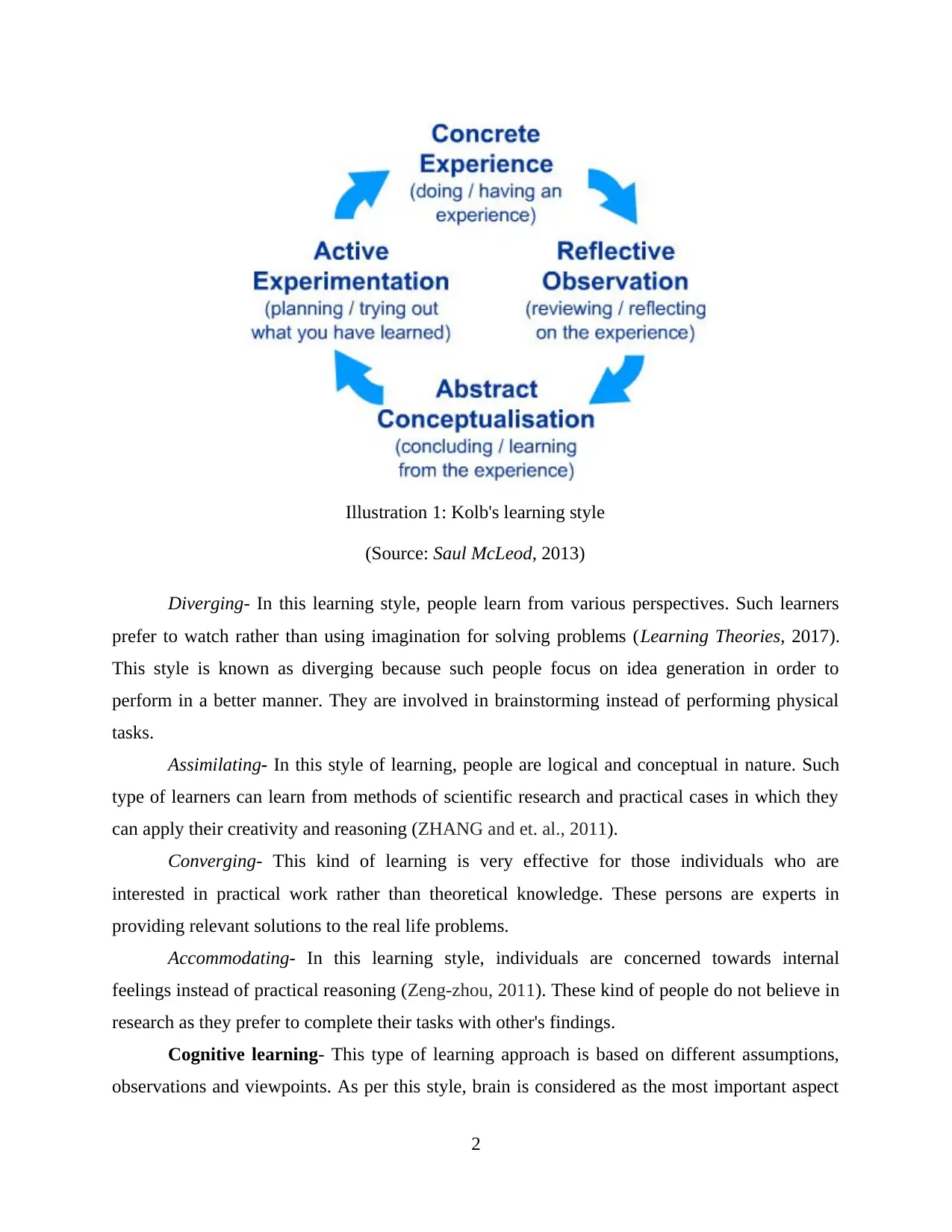
Illustration 1: Kolb's learning style
(Source: Saul McLeod, 2013)
Diverging- In this learning style, people learn from various perspectives. Such learners
prefer to watch rather than using imagination for solving problems (Learning Theories, 2017).
This style is known as diverging because such people focus on idea generation in order to
perform in a better manner. They are involved in brainstorming instead of performing physical
tasks.
Assimilating- In this style of learning, people are logical and conceptual in nature. Such
type of learners can learn from methods of scientific research and practical cases in which they
can apply their creativity and reasoning (ZHANG and et. al., 2011).
Converging- This kind of learning is very effective for those individuals who are
interested in practical work rather than theoretical knowledge. These persons are experts in
providing relevant solutions to the real life problems.
Accommodating- In this learning style, individuals are concerned towards internal
feelings instead of practical reasoning (Zeng-zhou, 2011). These kind of people do not believe in
research as they prefer to complete their tasks with other's findings.
Cognitive learning- This type of learning approach is based on different assumptions,
observations and viewpoints. As per this style, brain is considered as the most important aspect
2
(Source: Saul McLeod, 2013)
Diverging- In this learning style, people learn from various perspectives. Such learners
prefer to watch rather than using imagination for solving problems (Learning Theories, 2017).
This style is known as diverging because such people focus on idea generation in order to
perform in a better manner. They are involved in brainstorming instead of performing physical
tasks.
Assimilating- In this style of learning, people are logical and conceptual in nature. Such
type of learners can learn from methods of scientific research and practical cases in which they
can apply their creativity and reasoning (ZHANG and et. al., 2011).
Converging- This kind of learning is very effective for those individuals who are
interested in practical work rather than theoretical knowledge. These persons are experts in
providing relevant solutions to the real life problems.
Accommodating- In this learning style, individuals are concerned towards internal
feelings instead of practical reasoning (Zeng-zhou, 2011). These kind of people do not believe in
research as they prefer to complete their tasks with other's findings.
Cognitive learning- This type of learning approach is based on different assumptions,
observations and viewpoints. As per this style, brain is considered as the most important aspect
2
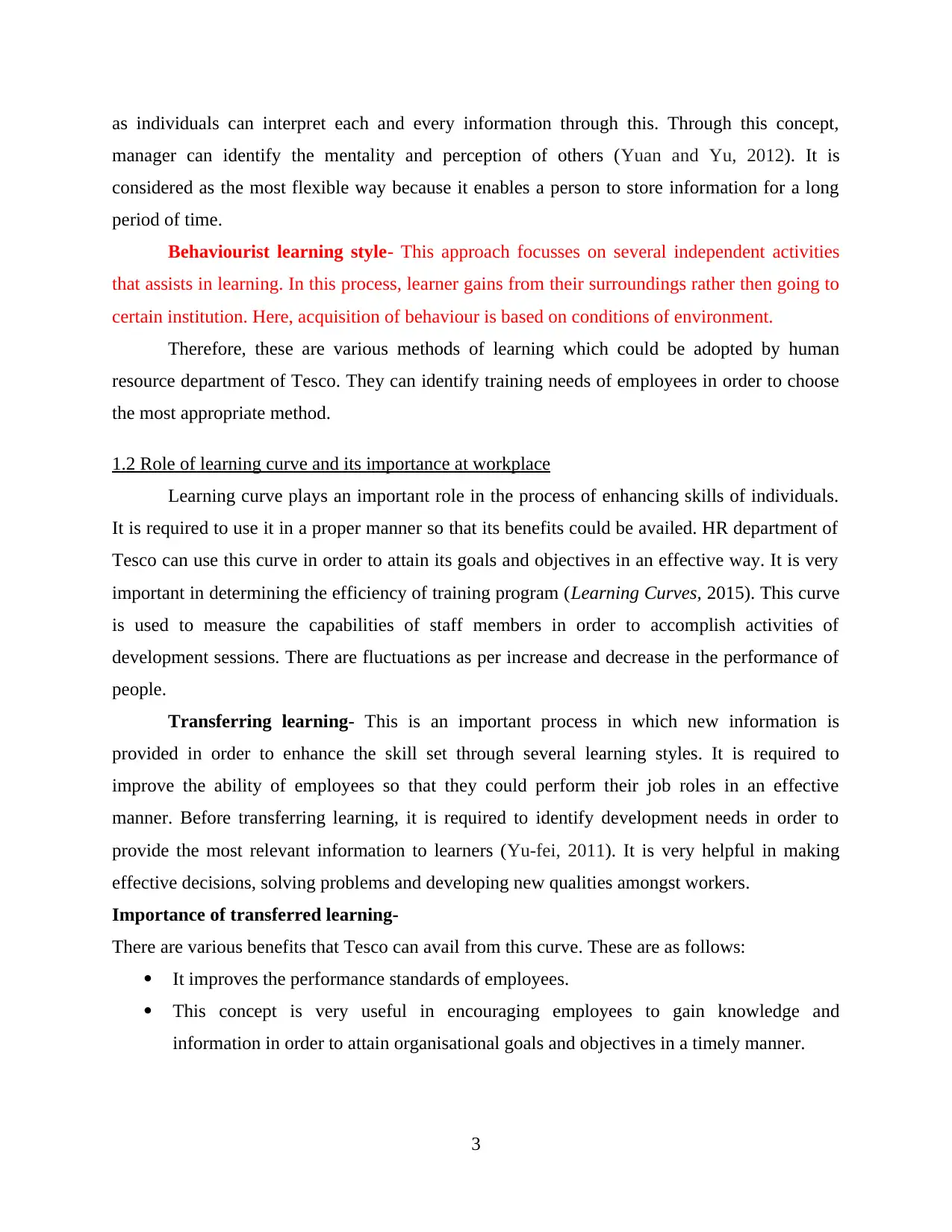
as individuals can interpret each and every information through this. Through this concept,
manager can identify the mentality and perception of others (Yuan and Yu, 2012). It is
considered as the most flexible way because it enables a person to store information for a long
period of time.
Behaviourist learning style- This approach focusses on several independent activities
that assists in learning. In this process, learner gains from their surroundings rather then going to
certain institution. Here, acquisition of behaviour is based on conditions of environment.
Therefore, these are various methods of learning which could be adopted by human
resource department of Tesco. They can identify training needs of employees in order to choose
the most appropriate method.
1.2 Role of learning curve and its importance at workplace
Learning curve plays an important role in the process of enhancing skills of individuals.
It is required to use it in a proper manner so that its benefits could be availed. HR department of
Tesco can use this curve in order to attain its goals and objectives in an effective way. It is very
important in determining the efficiency of training program (Learning Curves, 2015). This curve
is used to measure the capabilities of staff members in order to accomplish activities of
development sessions. There are fluctuations as per increase and decrease in the performance of
people.
Transferring learning- This is an important process in which new information is
provided in order to enhance the skill set through several learning styles. It is required to
improve the ability of employees so that they could perform their job roles in an effective
manner. Before transferring learning, it is required to identify development needs in order to
provide the most relevant information to learners (Yu-fei, 2011). It is very helpful in making
effective decisions, solving problems and developing new qualities amongst workers.
Importance of transferred learning-
There are various benefits that Tesco can avail from this curve. These are as follows:
It improves the performance standards of employees.
This concept is very useful in encouraging employees to gain knowledge and
information in order to attain organisational goals and objectives in a timely manner.
3
manager can identify the mentality and perception of others (Yuan and Yu, 2012). It is
considered as the most flexible way because it enables a person to store information for a long
period of time.
Behaviourist learning style- This approach focusses on several independent activities
that assists in learning. In this process, learner gains from their surroundings rather then going to
certain institution. Here, acquisition of behaviour is based on conditions of environment.
Therefore, these are various methods of learning which could be adopted by human
resource department of Tesco. They can identify training needs of employees in order to choose
the most appropriate method.
1.2 Role of learning curve and its importance at workplace
Learning curve plays an important role in the process of enhancing skills of individuals.
It is required to use it in a proper manner so that its benefits could be availed. HR department of
Tesco can use this curve in order to attain its goals and objectives in an effective way. It is very
important in determining the efficiency of training program (Learning Curves, 2015). This curve
is used to measure the capabilities of staff members in order to accomplish activities of
development sessions. There are fluctuations as per increase and decrease in the performance of
people.
Transferring learning- This is an important process in which new information is
provided in order to enhance the skill set through several learning styles. It is required to
improve the ability of employees so that they could perform their job roles in an effective
manner. Before transferring learning, it is required to identify development needs in order to
provide the most relevant information to learners (Yu-fei, 2011). It is very helpful in making
effective decisions, solving problems and developing new qualities amongst workers.
Importance of transferred learning-
There are various benefits that Tesco can avail from this curve. These are as follows:
It improves the performance standards of employees.
This concept is very useful in encouraging employees to gain knowledge and
information in order to attain organisational goals and objectives in a timely manner.
3
⊘ This is a preview!⊘
Do you want full access?
Subscribe today to unlock all pages.

Trusted by 1+ million students worldwide
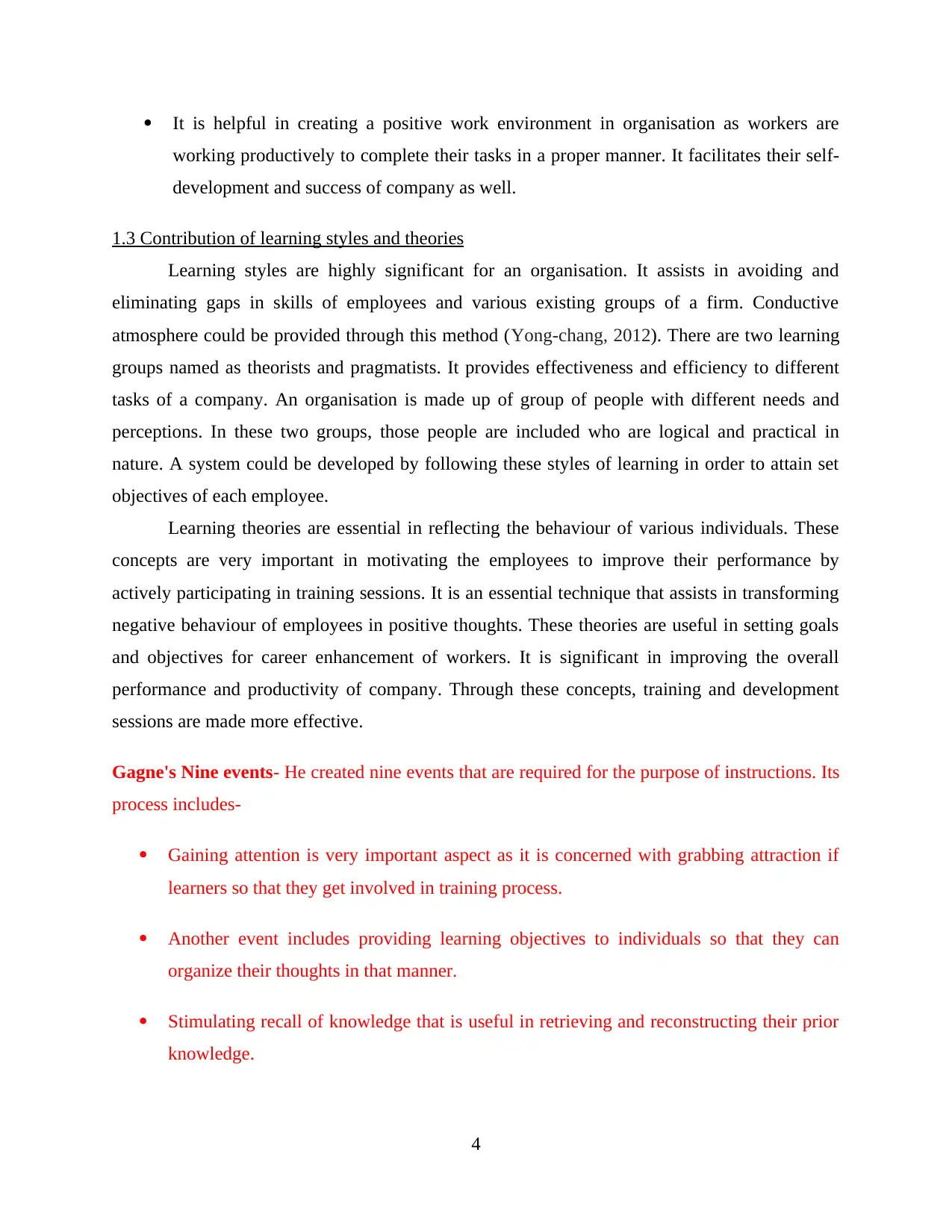
It is helpful in creating a positive work environment in organisation as workers are
working productively to complete their tasks in a proper manner. It facilitates their self-
development and success of company as well.
1.3 Contribution of learning styles and theories
Learning styles are highly significant for an organisation. It assists in avoiding and
eliminating gaps in skills of employees and various existing groups of a firm. Conductive
atmosphere could be provided through this method (Yong-chang, 2012). There are two learning
groups named as theorists and pragmatists. It provides effectiveness and efficiency to different
tasks of a company. An organisation is made up of group of people with different needs and
perceptions. In these two groups, those people are included who are logical and practical in
nature. A system could be developed by following these styles of learning in order to attain set
objectives of each employee.
Learning theories are essential in reflecting the behaviour of various individuals. These
concepts are very important in motivating the employees to improve their performance by
actively participating in training sessions. It is an essential technique that assists in transforming
negative behaviour of employees in positive thoughts. These theories are useful in setting goals
and objectives for career enhancement of workers. It is significant in improving the overall
performance and productivity of company. Through these concepts, training and development
sessions are made more effective.
Gagne's Nine events- He created nine events that are required for the purpose of instructions. Its
process includes-
Gaining attention is very important aspect as it is concerned with grabbing attraction if
learners so that they get involved in training process.
Another event includes providing learning objectives to individuals so that they can
organize their thoughts in that manner.
Stimulating recall of knowledge that is useful in retrieving and reconstructing their prior
knowledge.
4
working productively to complete their tasks in a proper manner. It facilitates their self-
development and success of company as well.
1.3 Contribution of learning styles and theories
Learning styles are highly significant for an organisation. It assists in avoiding and
eliminating gaps in skills of employees and various existing groups of a firm. Conductive
atmosphere could be provided through this method (Yong-chang, 2012). There are two learning
groups named as theorists and pragmatists. It provides effectiveness and efficiency to different
tasks of a company. An organisation is made up of group of people with different needs and
perceptions. In these two groups, those people are included who are logical and practical in
nature. A system could be developed by following these styles of learning in order to attain set
objectives of each employee.
Learning theories are essential in reflecting the behaviour of various individuals. These
concepts are very important in motivating the employees to improve their performance by
actively participating in training sessions. It is an essential technique that assists in transforming
negative behaviour of employees in positive thoughts. These theories are useful in setting goals
and objectives for career enhancement of workers. It is significant in improving the overall
performance and productivity of company. Through these concepts, training and development
sessions are made more effective.
Gagne's Nine events- He created nine events that are required for the purpose of instructions. Its
process includes-
Gaining attention is very important aspect as it is concerned with grabbing attraction if
learners so that they get involved in training process.
Another event includes providing learning objectives to individuals so that they can
organize their thoughts in that manner.
Stimulating recall of knowledge that is useful in retrieving and reconstructing their prior
knowledge.
4
Paraphrase This Document
Need a fresh take? Get an instant paraphrase of this document with our AI Paraphraser
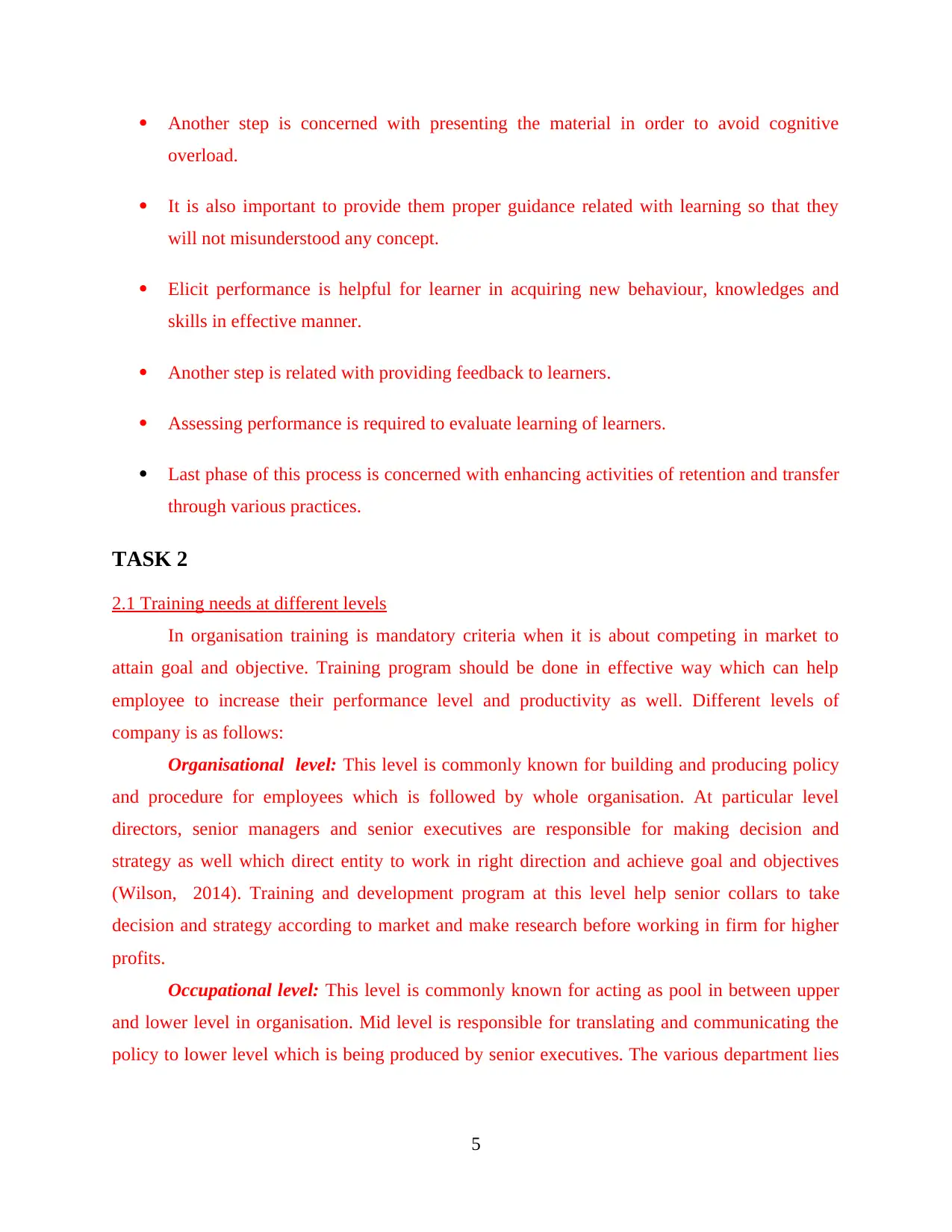
Another step is concerned with presenting the material in order to avoid cognitive
overload.
It is also important to provide them proper guidance related with learning so that they
will not misunderstood any concept.
Elicit performance is helpful for learner in acquiring new behaviour, knowledges and
skills in effective manner.
Another step is related with providing feedback to learners.
Assessing performance is required to evaluate learning of learners.
Last phase of this process is concerned with enhancing activities of retention and transfer
through various practices.
TASK 2
2.1 Training needs at different levels
In organisation training is mandatory criteria when it is about competing in market to
attain goal and objective. Training program should be done in effective way which can help
employee to increase their performance level and productivity as well. Different levels of
company is as follows:
Organisational level: This level is commonly known for building and producing policy
and procedure for employees which is followed by whole organisation. At particular level
directors, senior managers and senior executives are responsible for making decision and
strategy as well which direct entity to work in right direction and achieve goal and objectives
(Wilson, 2014). Training and development program at this level help senior collars to take
decision and strategy according to market and make research before working in firm for higher
profits.
Occupational level: This level is commonly known for acting as pool in between upper
and lower level in organisation. Mid level is responsible for translating and communicating the
policy to lower level which is being produced by senior executives. The various department lies
5
overload.
It is also important to provide them proper guidance related with learning so that they
will not misunderstood any concept.
Elicit performance is helpful for learner in acquiring new behaviour, knowledges and
skills in effective manner.
Another step is related with providing feedback to learners.
Assessing performance is required to evaluate learning of learners.
Last phase of this process is concerned with enhancing activities of retention and transfer
through various practices.
TASK 2
2.1 Training needs at different levels
In organisation training is mandatory criteria when it is about competing in market to
attain goal and objective. Training program should be done in effective way which can help
employee to increase their performance level and productivity as well. Different levels of
company is as follows:
Organisational level: This level is commonly known for building and producing policy
and procedure for employees which is followed by whole organisation. At particular level
directors, senior managers and senior executives are responsible for making decision and
strategy as well which direct entity to work in right direction and achieve goal and objectives
(Wilson, 2014). Training and development program at this level help senior collars to take
decision and strategy according to market and make research before working in firm for higher
profits.
Occupational level: This level is commonly known for acting as pool in between upper
and lower level in organisation. Mid level is responsible for translating and communicating the
policy to lower level which is being produced by senior executives. The various department lies
5
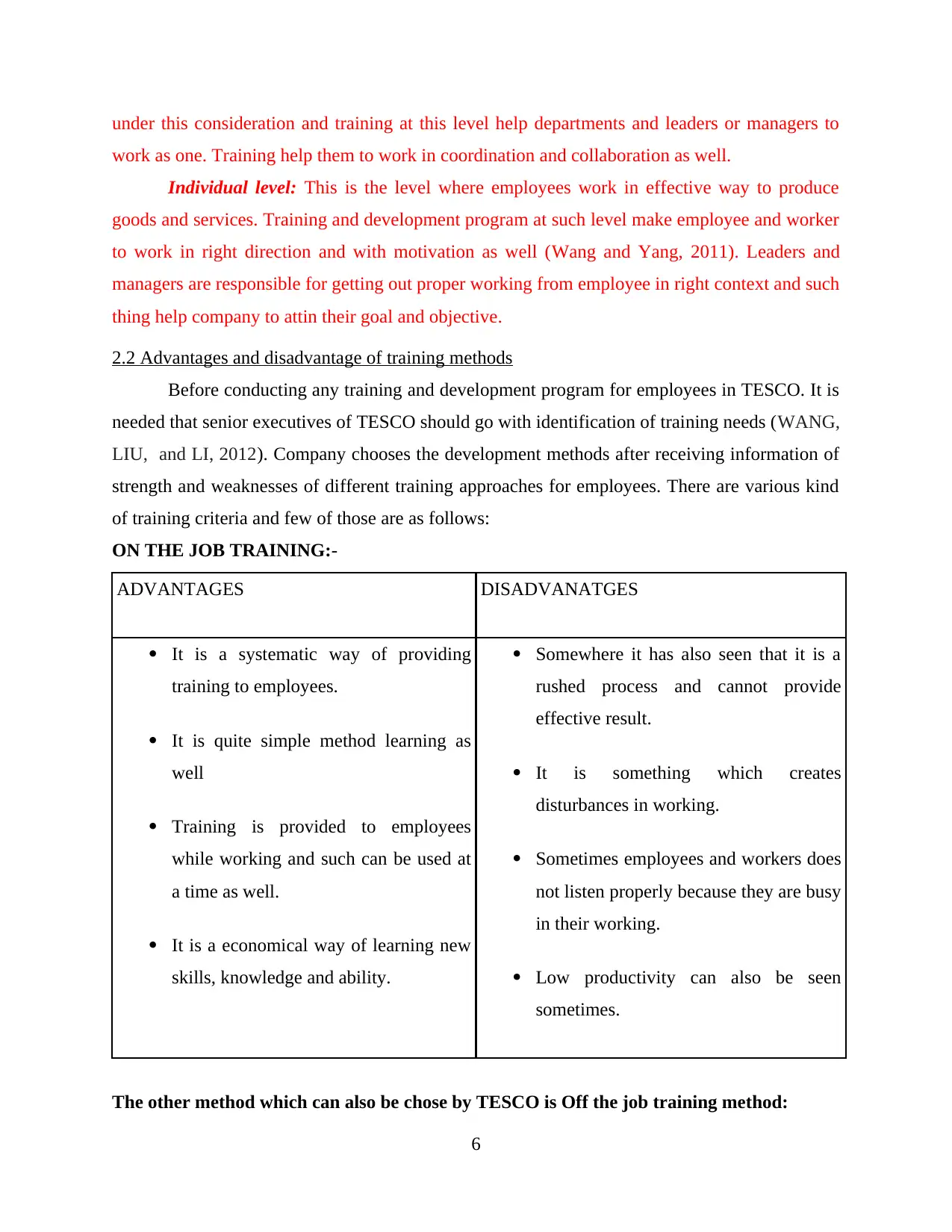
under this consideration and training at this level help departments and leaders or managers to
work as one. Training help them to work in coordination and collaboration as well.
Individual level: This is the level where employees work in effective way to produce
goods and services. Training and development program at such level make employee and worker
to work in right direction and with motivation as well (Wang and Yang, 2011). Leaders and
managers are responsible for getting out proper working from employee in right context and such
thing help company to attin their goal and objective.
2.2 Advantages and disadvantage of training methods
Before conducting any training and development program for employees in TESCO. It is
needed that senior executives of TESCO should go with identification of training needs (WANG,
LIU, and LI, 2012). Company chooses the development methods after receiving information of
strength and weaknesses of different training approaches for employees. There are various kind
of training criteria and few of those are as follows:
ON THE JOB TRAINING:-
ADVANTAGES DISADVANATGES
It is a systematic way of providing
training to employees.
It is quite simple method learning as
well
Training is provided to employees
while working and such can be used at
a time as well.
It is a economical way of learning new
skills, knowledge and ability.
Somewhere it has also seen that it is a
rushed process and cannot provide
effective result.
It is something which creates
disturbances in working.
Sometimes employees and workers does
not listen properly because they are busy
in their working.
Low productivity can also be seen
sometimes.
The other method which can also be chose by TESCO is Off the job training method:
6
work as one. Training help them to work in coordination and collaboration as well.
Individual level: This is the level where employees work in effective way to produce
goods and services. Training and development program at such level make employee and worker
to work in right direction and with motivation as well (Wang and Yang, 2011). Leaders and
managers are responsible for getting out proper working from employee in right context and such
thing help company to attin their goal and objective.
2.2 Advantages and disadvantage of training methods
Before conducting any training and development program for employees in TESCO. It is
needed that senior executives of TESCO should go with identification of training needs (WANG,
LIU, and LI, 2012). Company chooses the development methods after receiving information of
strength and weaknesses of different training approaches for employees. There are various kind
of training criteria and few of those are as follows:
ON THE JOB TRAINING:-
ADVANTAGES DISADVANATGES
It is a systematic way of providing
training to employees.
It is quite simple method learning as
well
Training is provided to employees
while working and such can be used at
a time as well.
It is a economical way of learning new
skills, knowledge and ability.
Somewhere it has also seen that it is a
rushed process and cannot provide
effective result.
It is something which creates
disturbances in working.
Sometimes employees and workers does
not listen properly because they are busy
in their working.
Low productivity can also be seen
sometimes.
The other method which can also be chose by TESCO is Off the job training method:
6
⊘ This is a preview!⊘
Do you want full access?
Subscribe today to unlock all pages.

Trusted by 1+ million students worldwide
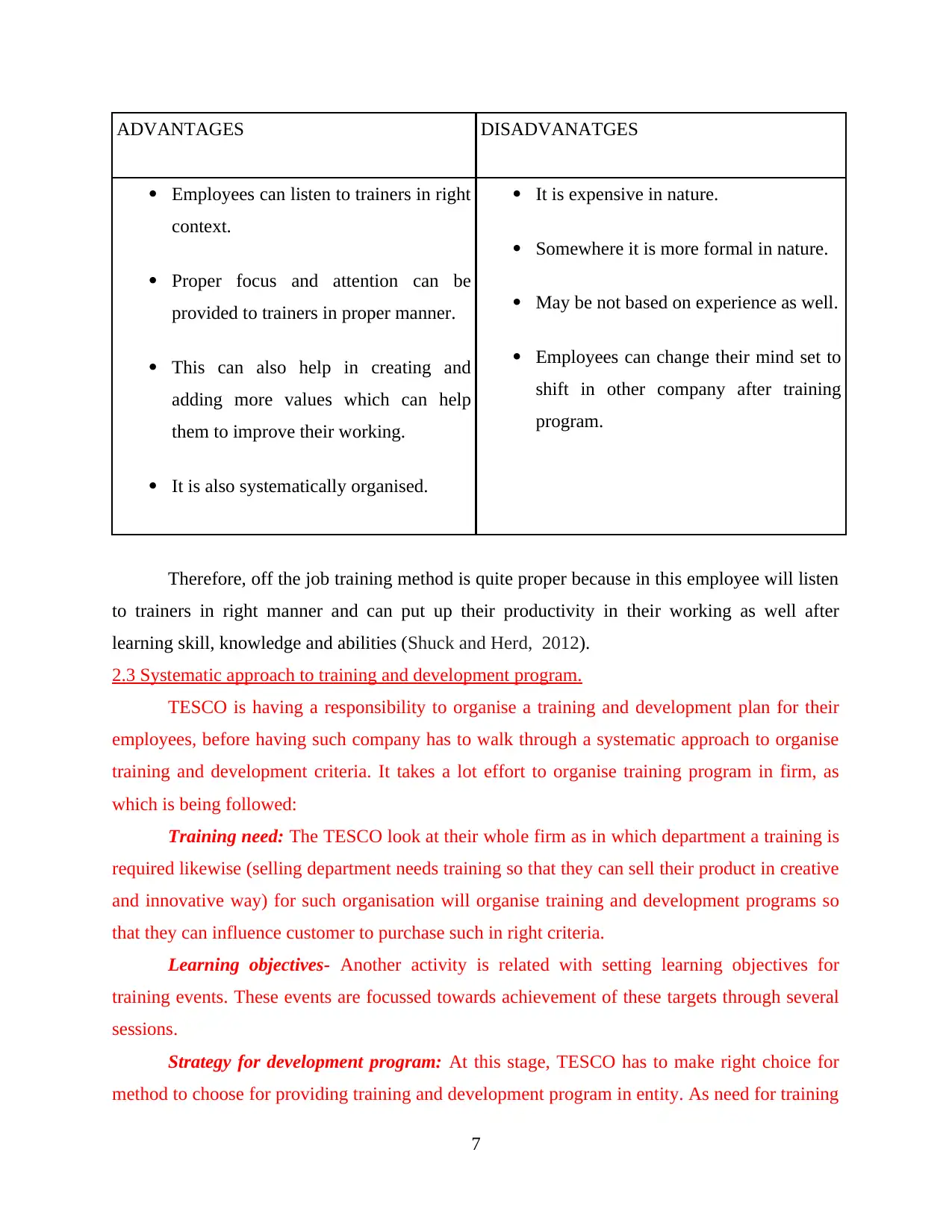
ADVANTAGES DISADVANATGES
Employees can listen to trainers in right
context.
Proper focus and attention can be
provided to trainers in proper manner.
This can also help in creating and
adding more values which can help
them to improve their working.
It is also systematically organised.
It is expensive in nature.
Somewhere it is more formal in nature.
May be not based on experience as well.
Employees can change their mind set to
shift in other company after training
program.
Therefore, off the job training method is quite proper because in this employee will listen
to trainers in right manner and can put up their productivity in their working as well after
learning skill, knowledge and abilities (Shuck and Herd, 2012).
2.3 Systematic approach to training and development program.
TESCO is having a responsibility to organise a training and development plan for their
employees, before having such company has to walk through a systematic approach to organise
training and development criteria. It takes a lot effort to organise training program in firm, as
which is being followed:
Training need: The TESCO look at their whole firm as in which department a training is
required likewise (selling department needs training so that they can sell their product in creative
and innovative way) for such organisation will organise training and development programs so
that they can influence customer to purchase such in right criteria.
Learning objectives- Another activity is related with setting learning objectives for
training events. These events are focussed towards achievement of these targets through several
sessions.
Strategy for development program: At this stage, TESCO has to make right choice for
method to choose for providing training and development program in entity. As need for training
7
Employees can listen to trainers in right
context.
Proper focus and attention can be
provided to trainers in proper manner.
This can also help in creating and
adding more values which can help
them to improve their working.
It is also systematically organised.
It is expensive in nature.
Somewhere it is more formal in nature.
May be not based on experience as well.
Employees can change their mind set to
shift in other company after training
program.
Therefore, off the job training method is quite proper because in this employee will listen
to trainers in right manner and can put up their productivity in their working as well after
learning skill, knowledge and abilities (Shuck and Herd, 2012).
2.3 Systematic approach to training and development program.
TESCO is having a responsibility to organise a training and development plan for their
employees, before having such company has to walk through a systematic approach to organise
training and development criteria. It takes a lot effort to organise training program in firm, as
which is being followed:
Training need: The TESCO look at their whole firm as in which department a training is
required likewise (selling department needs training so that they can sell their product in creative
and innovative way) for such organisation will organise training and development programs so
that they can influence customer to purchase such in right criteria.
Learning objectives- Another activity is related with setting learning objectives for
training events. These events are focussed towards achievement of these targets through several
sessions.
Strategy for development program: At this stage, TESCO has to make right choice for
method to choose for providing training and development program in entity. As need for training
7
Paraphrase This Document
Need a fresh take? Get an instant paraphrase of this document with our AI Paraphraser
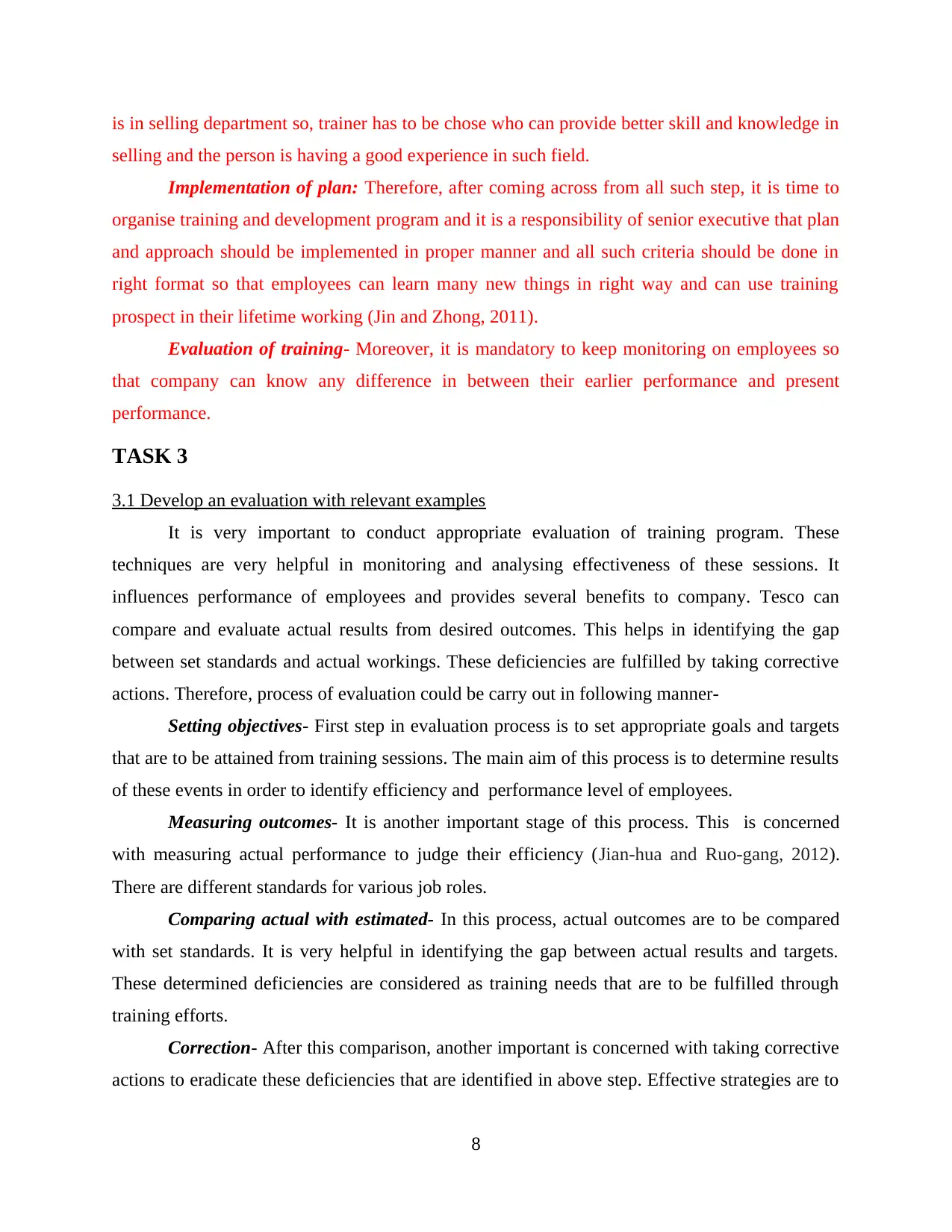
is in selling department so, trainer has to be chose who can provide better skill and knowledge in
selling and the person is having a good experience in such field.
Implementation of plan: Therefore, after coming across from all such step, it is time to
organise training and development program and it is a responsibility of senior executive that plan
and approach should be implemented in proper manner and all such criteria should be done in
right format so that employees can learn many new things in right way and can use training
prospect in their lifetime working (Jin and Zhong, 2011).
Evaluation of training- Moreover, it is mandatory to keep monitoring on employees so
that company can know any difference in between their earlier performance and present
performance.
TASK 3
3.1 Develop an evaluation with relevant examples
It is very important to conduct appropriate evaluation of training program. These
techniques are very helpful in monitoring and analysing effectiveness of these sessions. It
influences performance of employees and provides several benefits to company. Tesco can
compare and evaluate actual results from desired outcomes. This helps in identifying the gap
between set standards and actual workings. These deficiencies are fulfilled by taking corrective
actions. Therefore, process of evaluation could be carry out in following manner-
Setting objectives- First step in evaluation process is to set appropriate goals and targets
that are to be attained from training sessions. The main aim of this process is to determine results
of these events in order to identify efficiency and performance level of employees.
Measuring outcomes- It is another important stage of this process. This is concerned
with measuring actual performance to judge their efficiency (Jian-hua and Ruo-gang, 2012).
There are different standards for various job roles.
Comparing actual with estimated- In this process, actual outcomes are to be compared
with set standards. It is very helpful in identifying the gap between actual results and targets.
These determined deficiencies are considered as training needs that are to be fulfilled through
training efforts.
Correction- After this comparison, another important is concerned with taking corrective
actions to eradicate these deficiencies that are identified in above step. Effective strategies are to
8
selling and the person is having a good experience in such field.
Implementation of plan: Therefore, after coming across from all such step, it is time to
organise training and development program and it is a responsibility of senior executive that plan
and approach should be implemented in proper manner and all such criteria should be done in
right format so that employees can learn many new things in right way and can use training
prospect in their lifetime working (Jin and Zhong, 2011).
Evaluation of training- Moreover, it is mandatory to keep monitoring on employees so
that company can know any difference in between their earlier performance and present
performance.
TASK 3
3.1 Develop an evaluation with relevant examples
It is very important to conduct appropriate evaluation of training program. These
techniques are very helpful in monitoring and analysing effectiveness of these sessions. It
influences performance of employees and provides several benefits to company. Tesco can
compare and evaluate actual results from desired outcomes. This helps in identifying the gap
between set standards and actual workings. These deficiencies are fulfilled by taking corrective
actions. Therefore, process of evaluation could be carry out in following manner-
Setting objectives- First step in evaluation process is to set appropriate goals and targets
that are to be attained from training sessions. The main aim of this process is to determine results
of these events in order to identify efficiency and performance level of employees.
Measuring outcomes- It is another important stage of this process. This is concerned
with measuring actual performance to judge their efficiency (Jian-hua and Ruo-gang, 2012).
There are different standards for various job roles.
Comparing actual with estimated- In this process, actual outcomes are to be compared
with set standards. It is very helpful in identifying the gap between actual results and targets.
These determined deficiencies are considered as training needs that are to be fulfilled through
training efforts.
Correction- After this comparison, another important is concerned with taking corrective
actions to eradicate these deficiencies that are identified in above step. Effective strategies are to
8
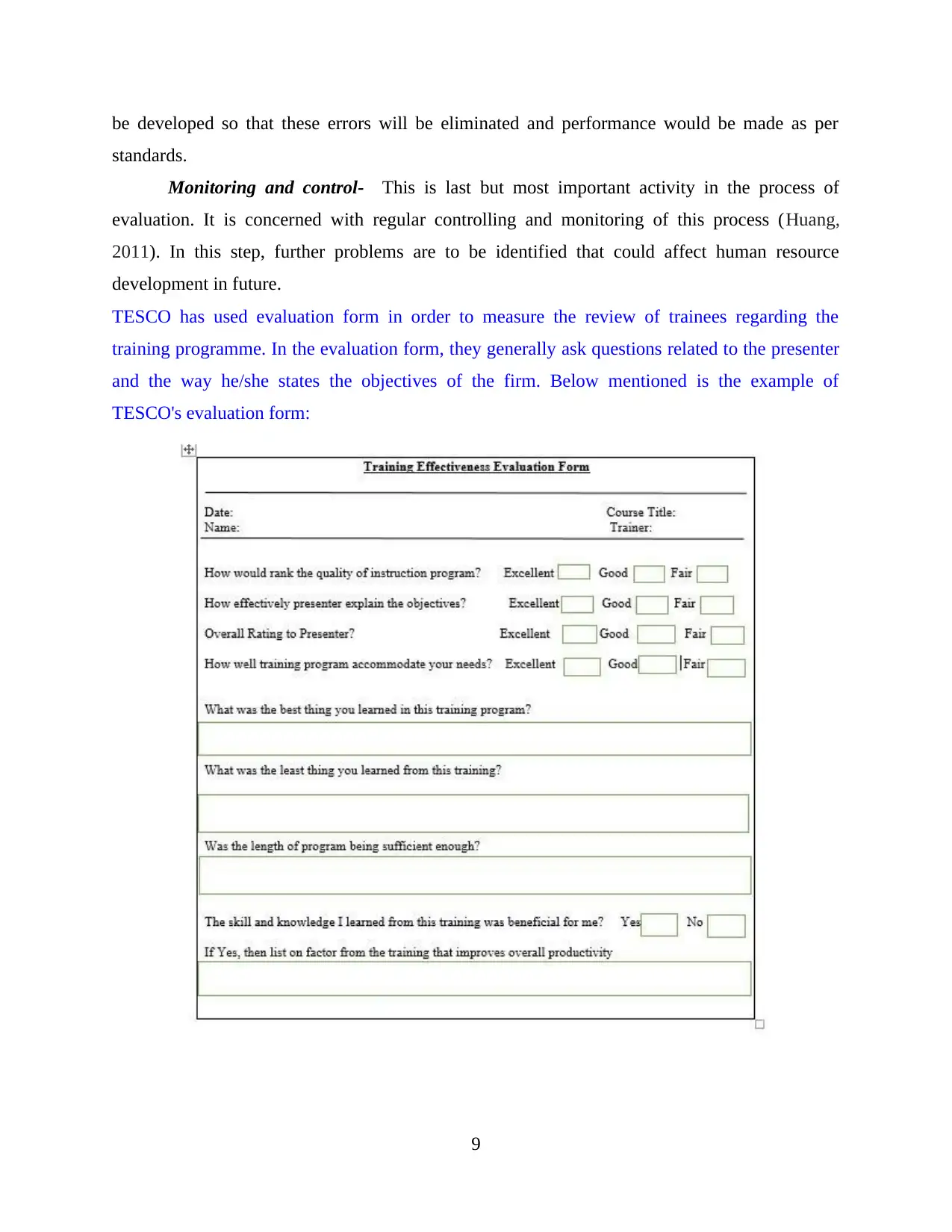
be developed so that these errors will be eliminated and performance would be made as per
standards.
Monitoring and control- This is last but most important activity in the process of
evaluation. It is concerned with regular controlling and monitoring of this process (Huang,
2011). In this step, further problems are to be identified that could affect human resource
development in future.
TESCO has used evaluation form in order to measure the review of trainees regarding the
training programme. In the evaluation form, they generally ask questions related to the presenter
and the way he/she states the objectives of the firm. Below mentioned is the example of
TESCO's evaluation form:
9
standards.
Monitoring and control- This is last but most important activity in the process of
evaluation. It is concerned with regular controlling and monitoring of this process (Huang,
2011). In this step, further problems are to be identified that could affect human resource
development in future.
TESCO has used evaluation form in order to measure the review of trainees regarding the
training programme. In the evaluation form, they generally ask questions related to the presenter
and the way he/she states the objectives of the firm. Below mentioned is the example of
TESCO's evaluation form:
9
⊘ This is a preview!⊘
Do you want full access?
Subscribe today to unlock all pages.

Trusted by 1+ million students worldwide
1 out of 21
Related Documents
Your All-in-One AI-Powered Toolkit for Academic Success.
+13062052269
info@desklib.com
Available 24*7 on WhatsApp / Email
![[object Object]](/_next/static/media/star-bottom.7253800d.svg)
Unlock your academic potential
Copyright © 2020–2025 A2Z Services. All Rights Reserved. Developed and managed by ZUCOL.





